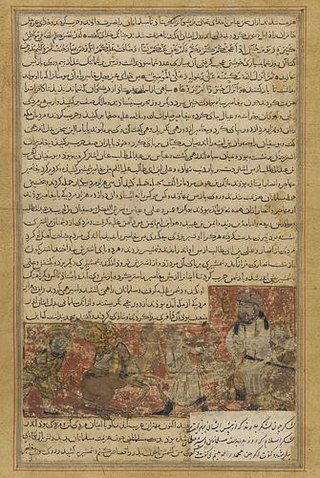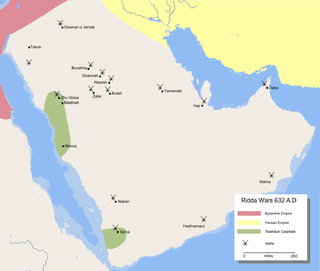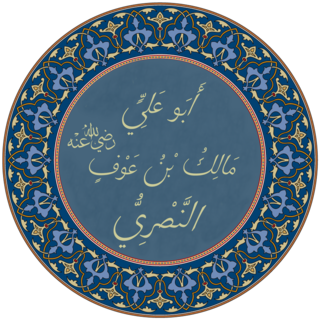Related Research Articles
Al-Abbas ibn Abd al-Muttalib was a paternal uncle and sahabi (companion) of the Islamic prophet Muhammad, just three years older than his nephew. A wealthy merchant, during the early years of Islam he protected Muhammad while he was in Mecca, but only became a convert after the Battle of Badr in 624 CE (2 AH). His descendants founded the Abbasid dynasty in 750.

The Banu Thaqif is an Arab tribe which inhabited, and still inhabits, the city of Ta'if and its environs, in modern Saudi Arabia, and played a prominent role in early Islamic history.
ʿAbd Allāh ibn Abī Bakr al-Taymī was a son of the first caliph Abu Bakr and a Companion of the Islamic prophet Muhammad.
Al-Ḥārith ibn ʿAbd al-Muṭṭalib was one of the uncles of Muhammad. He was the son of Abd al-Muttalib, of the Quraysh in Mecca, by his first wife, Sumra bint Jundab, who was from Hawazin tribe. For a long time his father, who took from him the kunya Abu al-Harith, had no other children.
Faḍl ibn ʿAbbās was a brother of Abd Allah ibn Abbas and was a cousin of the Islamic prophet Muhammad.
Ṣafwān ibn Umayya was a sahabi (companion) of the Islamic prophet Muhammad.

The Battle of Hunayn was a conflict between the Muslims of the Islamic prophet Muhammad and the tribe of Qays in the aftermath of the conquest of Mecca. The battle took place in 8 AH in the Hunayn valley on the route from Mecca to Taif. The battle ultimately ended in a decisive victory for the Muslims, and it is one of the few battles mentioned by name in the Qur'an, where it appears in Surat at-Tawbah.
Uthman ibn Abi al-As al-Thaqafi was a companion of the Islamic prophet Muhammad from the tribe of Banu Thaqif and the governor of Bahrayn and Oman in 636–650, during the reigns of caliphs Umar and Uthman. During his governorship he led military campaigns against the Sasanian Persians in Fars. After his dismissal, he settled with his brothers in Basra where he was granted a large estate by the caliph. He transmitted numerous hadiths to the scholar al-Hasan al-Basri and died in the city.
Abu Abd Allah al-Mughira ibn Shu'ba ibn Abi Amir ibn Mas'ud al-Thaqafi ; c. 600–671), was a prominent companion of the Islamic prophet Muhammad and was known as one of the four 'shrewds of the Arabs'. He belonged to the tribe of Thaqif of Ta'if, who were part of the early Islamic elite. He served as governor of Kufa, one of the two principal Arab garrisons and administrative centers of Iraq, under Caliph Umar in 642–645. In his old age, al-Mughira was again made governor of Kufa, serving under the Umayyad caliph Mu'awiya I from 661 until his death in 671. During his second governorship, he ruled with virtual independence from the caliph.
Muhammad led the Conquest of Mecca in Ramadan of the Islamic year 8 AH. The Quraysh in Mecca was Muhammad's final major rival in the Arabian Peninsula, and following the conquest, Muhammad focused his military operations on further expansion of his Islamic realm to the north, with a campaign against the Ghassanids and the Byzantine Empire.
Abū ʿAbd Allāh Muḥammad ibn ʿAbd Allāh ibn al-Ḥasan al-Muthannā ibn al-Ḥasan al-Mujtabā ibn ʿAlī ibn Abī Ṭālib or Muḥammad al-Nafs al-Zakiyya, was a descendant of the Islamic prophet Muhammad, through his daughter Fatimah. Known for his commanding oratory skills, amiable demeanor, and impressive build, he led the Alid Revolt in Medina, a failed rebellion, against the second Abbasid caliph Al-Mansur. He and a few hundred soldiers faced against a large Abbasid force under Isa ibn Musa, and he was killed on December 6, 762 CE.

The Hawazin were an Arab tribe originally based in the western Najd and around Ta'if in the Hejaz. They formed part of the larger Qays tribal group. The Hawazin consisted of the subtribes of Banu Sa'd, and Banu Jusham, as well as the powerful Banu Thaqif and Banu Amir, which were both often counted separately from the Hawazin.

ʿAbd Allāh ibn ʿUmar ibn al-Khaṭṭāb, commonly known as Ibn Umar, was a companion of the Islamic prophet Muhammad and a son of the second Caliph Umar. He was a prominent authority in hadith and law. He remained neutral during the events of the first Fitna (656–661).
Sakhr ibn Harb ibn Umayya, commonly known by his kunyaAbu Sufyan, was a prominent opponent-turned companion and father-in-law of the Islamic prophet Muhammad. He was the father of the first Umayyad caliph Mu'awiya I and namesake of the Sufyanid line of Umayyad caliphs which ruled from 661 to 684.
The expedition of Abu Amir Al-Ashari, took place in January 630 AD or 8AH, 10th month, of the Islamic Calendar, in Autas.
Expedition of Abu Sufyan ibn Harb or the Demolition of al-Lat, occurred in the same year as the Battle of Tabuk. Muhammad sent Abu Sufyan with a group armed men to destroy the Idol Allāt that was worshipped by the citizens of Taif. The destruction of the idol was a demand by Muhammad before any reconciliation could take place with the citizens of Taif.The event is also mentioned in the Quran verse 17:73.

The Battle of Dhu al-Qassah took place in the area of Dhu al-Qassah, located approximately 36 kilometres (22 mi) east of Medina, in the Medina Province, in the central-western part of Saudi Arabia, from July 25 to July 30, 632. It pitted the forces of the Rashidun Caliphate led by Caliph Abu Bakr As-Siddiq against the rebel apostates led by General Hibal ibn Khuwailid,.
Banu Tha'labah was a tribe during the Islamic prophet Muhammad's era. They were involved in many military conflicts with Muhammad.
Abū 'Ubayd ibn Mas'ūd ibn 'Amr ibn 'Umayr ibn 'Awf ibn Uqda ibn Ghayra ibn Awf ibn Thaqif al-Thaqafi, or simply Abu Ubayd, was a commander in the army of the Rashidun Caliphate. He was from Ta'if in western Arabia, and belonged to the tribe Banu Thaqif.

Malik ibn Awf was a companion of Muhammad and a leader of the Hawazin tribe of Ta'if. Before he converted to Islam, he was one of the commanders in the Battle of Hunayn against the Muslims. His tribe, the Ta'if, fought in the battle along with the Thaqif tribe. He was a prominent knight who commanded armies and held a high rank among his people. He converted to Islam before Muhammad's death.
References
- 1 2 Ashraf, Shahid (15 June 2005), Encyclopaedia Of Holy Prophet And Companion (Set Of 15 Vols.), Anmol Publications Pvt Ltd., p. 31, ISBN 978-81-261-1940-0 Page 31 in which volume?
- 1 2 "witness-pioneer.org". www.witness-pioneer.org. Archived from the original on July 17, 2010.
- ↑ Hawarey, Mosab (2010). The Journey of Prophecy; Days of Peace and War (Arabic). Islamic Book Trust.Note: Book contains a list of battles of Muhammad in Arabic, English translation available here Archived 2011-07-26 at the Wayback Machine
- ↑ "Victory".
- ↑ Irving, Washington (February 21, 2008), Lives of Mahomet and his successors, Kessinger Publishing, LLC, pp. 111–113, ISBN 978-0548883037 . Note: A Full version of this book is available free on Google books
- ↑ Tabari, Muhamad ibn al-Jarir. Tafsir al-Tabari (in Arabic). Muhammad ibn al-Jarir. pp. Surah al-Nisa, Verse 24.
6.[3] مختصر سيرة الرسول. الشيخ عبد الله بن محمد بن عبد الوهاب نسخة محفوظة 04 يوليو 2017 على موقع واي باك مشين.